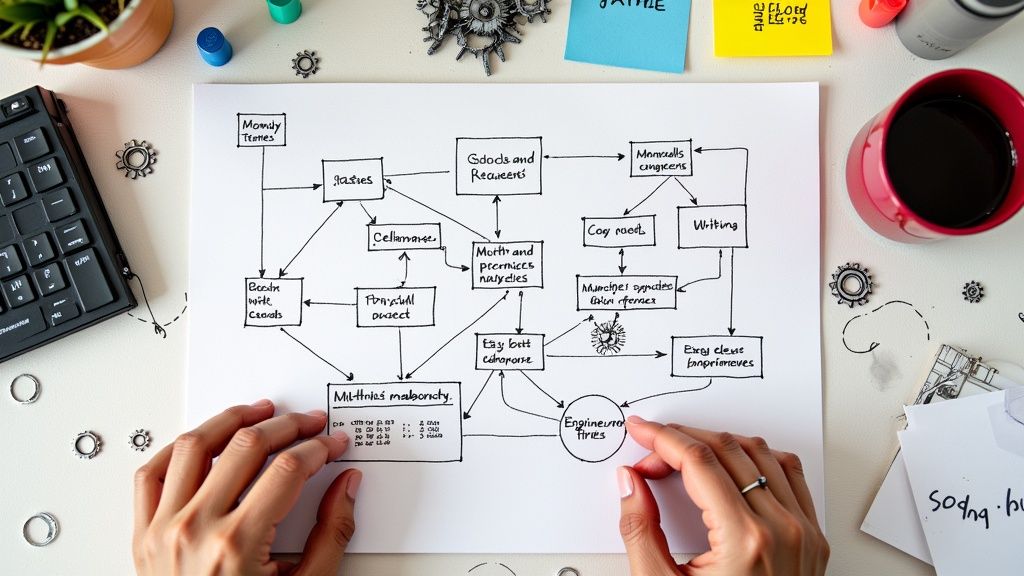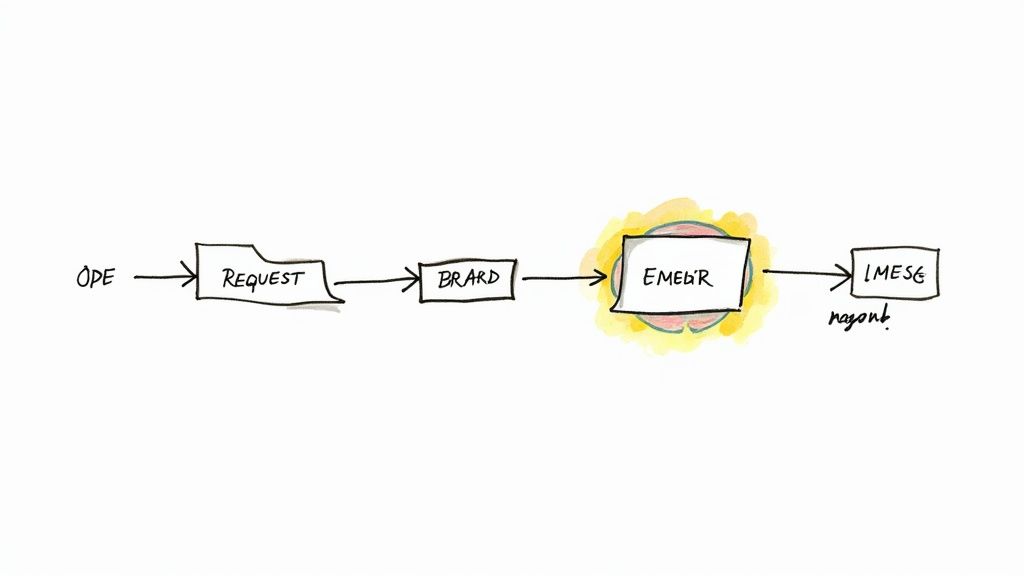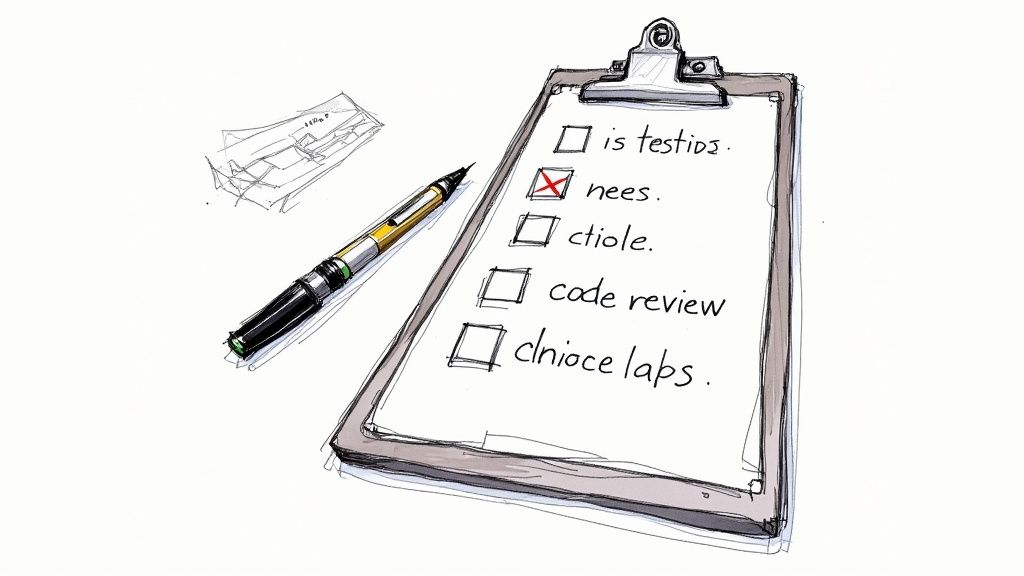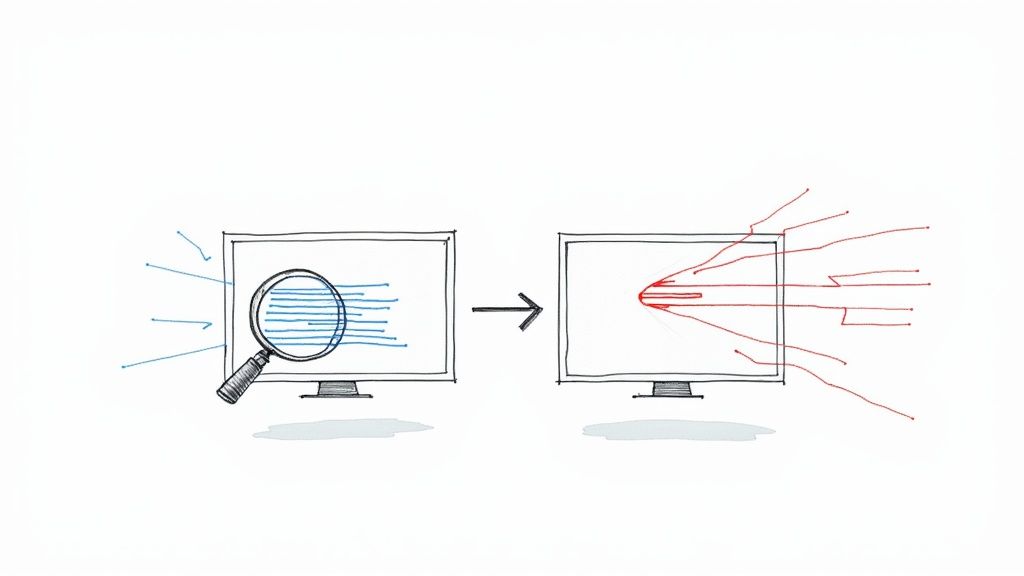Pull Request Best Practices: A Step-by-Step Guide to Engineering Excellence

Breaking Down the Art of Small Pull Requests

Small pull requests (PRs) make code reviews more effective and efficient. Research shows that PRs under 200 lines of code get merged faster and have higher success rates compared to larger ones. But keeping PRs small takes conscious effort and the right approach. Let's explore how to master the art of small, focused PRs.
Why Smaller Pull Requests Matter
Small PRs help reviewers do their jobs better. Think about trying to review thousands of lines of code at once - it's like trying to proofread an entire book in one sitting. Your eyes glaze over, you miss details, and the quality suffers. With smaller PRs, reviewers can give each line proper attention, catch potential issues early, and provide better feedback. Plus, if something goes wrong after merging, smaller PRs are much easier to roll back. Instead of undoing days of work, you can quickly revert the problematic changes and get back on track.
Practical Techniques for Creating Smaller PRs
Breaking down large changes into small PRs is a skill you can develop with practice. Start by looking for natural stopping points in your work - maybe it's completing a single function, fixing one bug, or adding a specific feature. Another helpful approach is to separate different types of changes. For example, if you're both cleaning up existing code and adding new functionality, make those two separate PRs. This makes the purpose of each change clear and helps reviewers focus on one thing at a time.
Establishing Size Guidelines and Maintaining Feature Coherence
While every project is different, having clear PR size guidelines helps teams stay on track. Many teams aim for 200-400 lines of code per PR as a general rule. But remember that these aren't strict limits - sometimes you need a bit more to complete a meaningful chunk of work. The key is making sure each PR delivers something useful on its own. Tools like Mergify can help by automating parts of the PR process, like merging PRs that meet your team's criteria. This frees up developers to focus on writing good code and following PR best practices. By combining size guidelines with tools and automation, you'll create a PR workflow that works smoothly for everyone involved.
Crafting Pull Requests That Actually Get Reviewed

Small pull requests are essential for effective code reviews, but getting your changes reviewed takes more than just keeping things concise. Even well-sized pull requests can sit untouched without the right approach. The key is crafting pull requests that actively engage reviewers and make the review process feel like a natural collaboration rather than a burdensome task. When you focus on clarity, context, and making life easier for your reviewers, you'll see a real improvement in how quickly and thoroughly your code gets reviewed.
Writing Compelling Pull Request Descriptions
The description is your chance to set the stage for a successful review. Think of it as a guide that helps reviewers understand your changes before they dive into the code. A good description needs to answer three key questions: Why did you make these changes? What specific problem are you solving? How does your solution work? For example, instead of a vague title like "Bug fix," be specific with something like "Fix memory leak in user authentication module."
Make your description easy to scan by using bullet points for key changes and including links to relevant documentation or issues. This approach gives reviewers a clear roadmap - they can quickly grasp what you've done and why it matters before getting into the details.
Structuring Your Changes for Readability
Like a well-organized essay makes complex ideas easier to follow, thoughtfully structured code changes make reviews more productive. Break your work into logical commits that each focus on one clear purpose. This helps reviewers follow your thinking and spot potential issues more easily. But be careful not to go overboard with tiny commits - you want enough detail to be clear without losing the big picture. For instance, if you're cleaning up related code, one focused commit often works better than scattered small tweaks.
Providing Context With Visual Aids and Documentation
Sometimes code alone doesn't tell the whole story. That's when visual aids and supporting documentation become invaluable. Screenshots or short videos can instantly clarify UI changes or complex algorithms in ways that words alone can't match. Adding links to design docs or API specs gives reviewers the background they need to evaluate your changes properly. These extra materials aren't just nice-to-haves - they help reviewers give more meaningful feedback and often speed up the whole process.
Utilizing Templates and Automation
A consistent approach makes reviews more efficient for everyone involved. Pull request templates ensure you include all the key information reviewers need, reducing back-and-forth questions. Tools like Mergify can help by automating routine tasks like merging approved pull requests that meet your team's standards. This combination of templates and automation tools helps maintain quality while keeping the process smooth and practical. When you put all these elements together - clear descriptions, thoughtful structure, helpful context, and smart automation - you create pull requests that reviewers actually want to review, building a stronger culture of collaboration on your team.
Building a Culture of Early Feedback

Good pull requests and smooth review processes are important, but they're just the start. The real key is building a work environment where feedback happens early and often. When teams share and discuss code changes from the beginning, they catch issues sooner and produce better quality code. Let's explore how successful engineering teams make early feedback a natural part of their daily work.
Leveraging Draft Pull Requests and Preliminary Reviews
Draft pull requests are perfect for getting early input from teammates. By sharing work-in-progress code, developers can spot potential problems before they become permanent parts of the codebase. This is especially helpful for big changes or tricky features. For example, when building new security features, a developer might share an early draft with the security team to make sure the approach is solid. Getting this feedback up front saves time and prevents major rewrites later.
Creating Psychological Safety in Code Reviews
Teams get the most from early feedback when everyone feels safe sharing unfinished work. This means building trust and making it clear that works-in-progress are welcome and expected. Think of it like having trusted friends to bounce ideas off of - you can test things out and refine them before making them final. This open environment helps newer developers learn directly from experienced team members while getting comfortable with code reviews.
Maintaining Momentum Throughout the Development Process
Getting feedback early helps teams keep moving forward smoothly. Instead of long debugging sessions or back-and-forth discussions late in the process, issues get solved quickly when they're still small. This steady progress fits perfectly with agile development and helps maintain a good working pace. Tools like Mergify can help by handling routine tasks automatically, like merging approved pull requests, so the team can focus on writing and reviewing code.
Practical Approaches to Handling Sensitive Feedback
The way teams give and receive feedback shapes their entire development culture. While early feedback is important, how it's delivered matters just as much. Focus comments on the code itself rather than the person who wrote it. For instance, instead of "This code is messy," try "We could make this function clearer by breaking it into smaller pieces." Similarly, receiving feedback with openness and curiosity helps everyone learn and grow together. When teams prioritize respectful communication, code reviews become a powerful way to improve code quality and help everyone get better at their craft.
Optimizing Your Review Workflow

Creating great pull requests is just the first step - you also need a solid review process that works for your whole team. The key is finding the right balance between thorough code reviews and maintaining development speed. Let's explore practical ways to build an efficient review workflow that helps teams ship high-quality code quickly.
Managing Multiple Reviewers Effectively
Having multiple reviewers brings different perspectives and helps catch issues that one person might miss. The trick is coordinating these reviews efficiently. Try assigning specific focus areas to each reviewer based on their expertise - for example, have security experts focus on potential vulnerabilities while UI specialists examine the user experience aspects. This targeted approach makes better use of everyone's time and knowledge. You'll also want to set clear expectations about review timing and designate a lead reviewer to gather and consolidate all the feedback.
Handling Complex Changes With Grace
Some pull requests involve major changes that need extra attention. For these complex PRs, breaking the review into focused segments often works better than trying to review everything at once. This helps reviewers stay sharp and give more thoughtful feedback. Consider scheduling dedicated review sessions where the team can discuss tricky parts together and resolve questions quickly. Taking this proactive approach helps prevent confusion and delays later on.
Ensuring Consistent Review Quality
Clear standards are essential for maintaining quality across all pull requests. Create specific review guidelines covering coding style, approval criteria, and other key checkpoints. This gives everyone a shared understanding of what "good" looks like and removes guesswork from the process. Don't forget to update these guidelines as your project grows and changes. Using review checklists can help reinforce best practices and ensure thorough reviews. Tools like Mergify can automate routine parts of the process, giving reviewers more time to focus on code quality.
Automation and Tooling for Streamlined Reviews
Smart use of automation makes reviews more efficient. Using tools to automatically check code style and run basic tests helps catch simple issues early, letting reviewers focus on deeper code analysis. For example, Mergify can automatically merge pull requests once they meet all requirements, removing manual steps that slow things down. When you combine thoughtful automation with well-designed review practices, teams can maintain high standards while shipping quality code consistently. The result is faster delivery without sacrificing code quality - exactly what most development teams are aiming for.
Measuring What Actually Matters
It's one thing to optimize your pull request workflow and encourage early feedback, but measuring the right metrics is what truly drives improvement. While basic numbers like total PRs completed can be misleading, focusing on meaningful metrics like cycle time and review depth provides real insights into your development process. Let's explore the key performance indicators that reveal where your team is excelling and where bottlenecks may be hiding.
Key Metrics for Pull Request Success
Understanding your PR process starts with tracking the right metrics consistently over time. Here are some of the most meaningful measurements to focus on:
- Cycle Time: This shows how long it takes for PRs to go from creation to merge. Teams practicing continuous delivery often target cycle times under 24 hours, as shorter times generally indicate smoother workflows.
- Review Depth: Look at factors like comments per PR and time spent reviewing code to gauge how thorough your reviews are. While detailed reviews often lead to better code quality, there's a balance - too much scrutiny can unnecessarily slow things down.
- Merge Rate: By comparing successful merges to total PRs created, you can spot potential issues. A high merge rate suggests things are working well, while consistently low rates may point to problems with code quality standards or communication gaps. For example, if only 60% of PRs get merged, you might need clearer acceptance criteria.
Interpreting the Data and Driving Actionable Insights
Simply collecting metrics isn't enough - you need to analyze the data to drive real improvements. This means looking for patterns, connecting different metrics, and investigating the root causes of issues you spot. For instance, if cycle times are creeping up, dig into whether PRs are getting larger, reviewers are overloaded, or requirements need more clarity.
Charts and graphs can help make the data easier to understand and share with the team. Rather than just looking at raw numbers, visual trends help everyone grasp what's working and what needs attention. This leads to better discussions and more targeted improvements.
Real-World Examples of Data-Driven Improvements
Many teams have successfully used metrics to transform their PR process. In one case, a team noticed they had an unusually high number of review cycles, with lots of back-and-forth between authors and reviewers. By creating clear PR templates and encouraging draft PRs for early feedback, they cut down review rounds significantly.
Another team found that large PRs had much lower merge rates than smaller ones. They responded by setting size guidelines and training developers on breaking down big changes into smaller, focused PRs. This led to faster reviews and fewer issues making it to production. These examples show how measuring the right things - and acting on those insights - helps teams steadily improve their development process, resulting in better code delivered more quickly.
Implementing Continuous Improvement
Success with pull requests requires ongoing refinement and adaptation. Your PR process should grow and improve alongside your codebase and team. By focusing on feedback, measurement, and iteration, you can turn your PR workflow into a dynamic system that boosts code quality while keeping developers engaged and productive.
Gathering Team Input and Fostering Open Communication
Great PR processes start with listening to your team. Schedule regular check-ins to understand what's working and what isn't - this could be through informal chats, team surveys, or dedicated retrospectives. For example, you might hold a monthly meeting where developers share their experiences with recent code reviews, discuss bottlenecks, and suggest improvements. This open dialogue helps spot optimization opportunities and ensures everyone understands and supports process changes.
Experimenting With Process Changes and Measuring Impact
After identifying areas to improve, test out different approaches systematically. Your team might try limiting PR sizes or adjusting review workflows. Treat each change as an experiment with clear success metrics - like how long reviews take, how thorough they are, and whether they catch bugs effectively. Using real data to guide decisions builds confidence in changes and encourages participation. Consider creating a simple dashboard to track and share key metrics with the team.
Frameworks for Benchmarking, Tracking Progress, and Celebrating Wins
Set clear goals to guide your improvement efforts. Compare your team's performance against industry standards or your own historical data to stay motivated and demonstrate progress. Keep the team updated on improvements and challenges through regular check-ins. Most importantly, take time to recognize and celebrate progress - whether it's faster review cycles or fewer bugs making it to production. Small wins add up, reinforcing good practices and building momentum for continued refinement of your PR process.
Get started improving your team's code review process with Mergify. Try it today to see how it can enhance your workflow!





